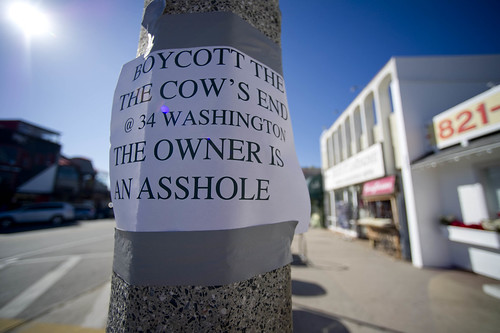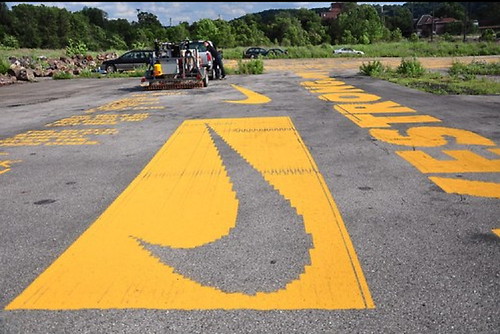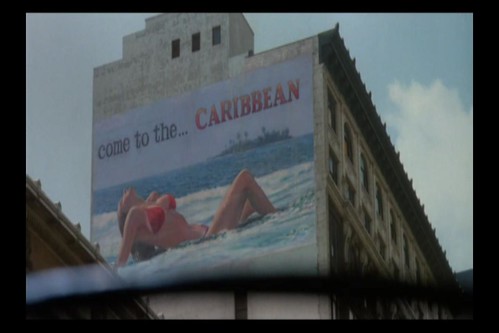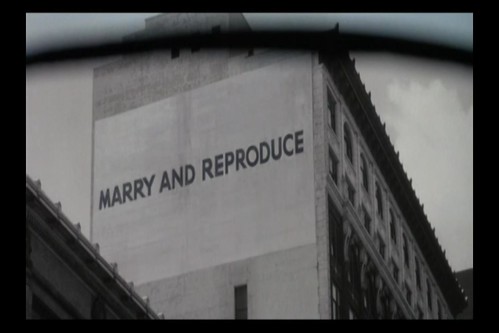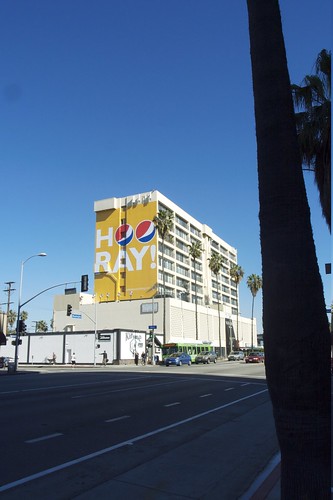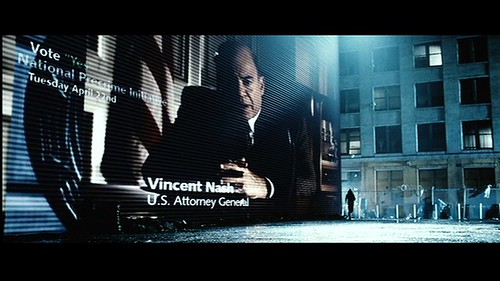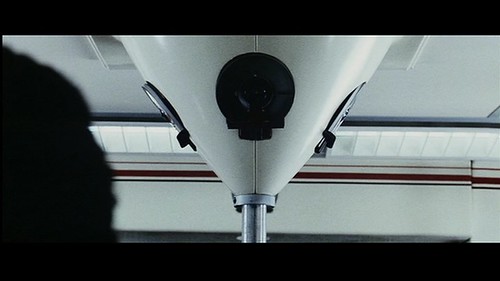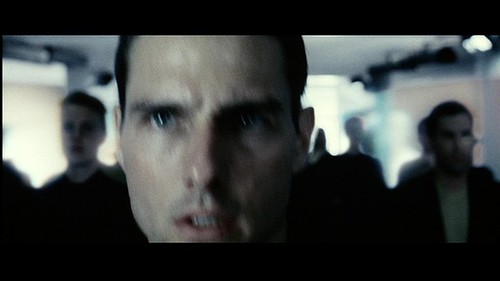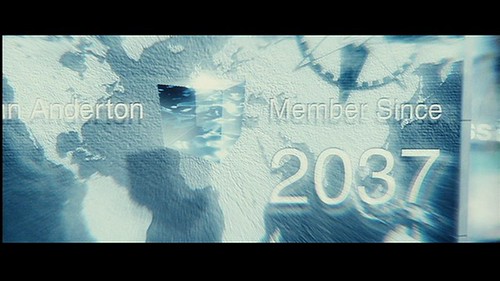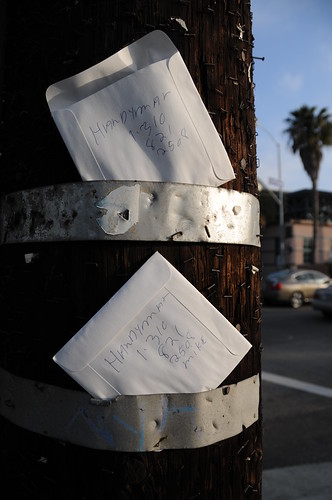A curious instantiation of temperament, attitude and confrontation seen on a Christmas Day stroll along Venice Beach.
Continue reading Physical Manifestations
Category: Advertising
A Trio Of Posted Things
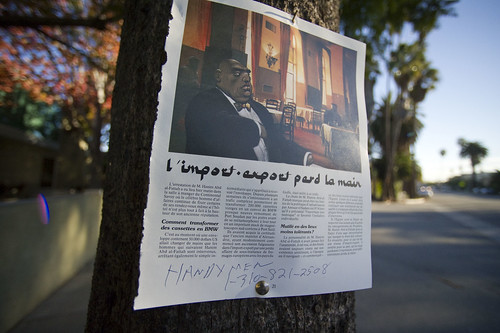
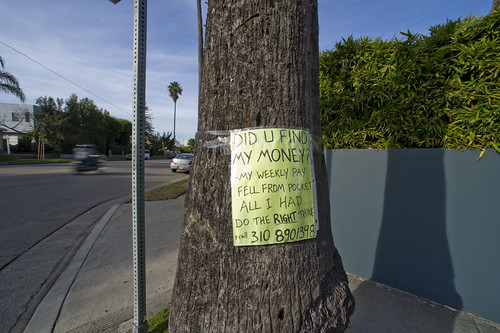
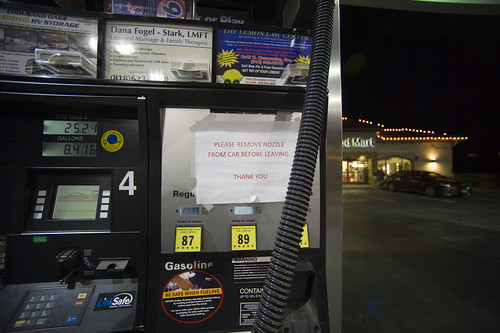
Chalkbot Versus GraffitiWriter…Round One! Ready….FIGHT!


From the Laboratory’s Bureau of Historical Precedence comes this dispatch: A colleague here in the studio, in a thread about Jeremy Wood’s GPS Drawing mentioned this ChalkBot robot that Nike has deployed to help promote, well — cancer awareness with the Lance Armstrong tie-in and itself by extension — at the Tour de France road race. When he started describing it, my mind immediately jumped to Josh Kinberg’s “Bikes Against Bush” project in which he used a bicycle-drawn rig to spray chalk on the pavement, in precisely the fashion of the ChalkBot — and Josh got tossed in the Pokey in the bargain! I wrote a note to Josh, curious if he was involved (if only to track and admire the activities of friends, etc) and he reminded me of the Institute for Applied Autonomy‘s GraffitiWriter and StreetWriter projects, which were his inspiration. (The data fragmentation in my human algorithm started clearing a bit.) An hour or two later, this press release appeared on the wonderfully dyspeptic, exceptionally over-sensitive, super grouse-y nettime from one of the IAA’s agents: read on
Continue reading Chalkbot Versus GraffitiWriter…Round One! Ready….FIGHT!
Design Fiction Chronicles: The Augmented Reality Near Future Imaginary Par Excellance
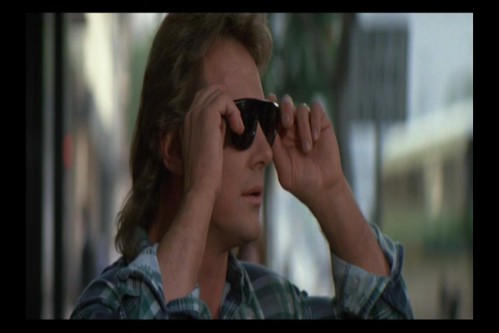
Well, the recent round of chit-chat about augmented realities and their current canonical motivations, design prototyping and concepts has leveled-up in my own mind. On the 12th floor of the Laboratory complex, we’ve decided to fill up the vacant cubicles and set up some bits of kit, post-it notes, fiducial-filled sheets of paper, and set up our new Bureau of Inquests Into Reality Augmentation & Alteration.
It’s early days, but we’ve found one near past design fiction of a possible augmented reality prototype in John Carpenter’s camp-fantastico film They Live. If you haven’t seen it, you know nothing about Augmented Reality. I’m so serious about that, my hands are shaking. A few years ago, when I was teaching a lecture class that ran four hours and was about as painful as you could imagine to prepare, until I realized it was four hours because it was a film class that was meant to show films – I had They Live pulled from the vaults or whatever for a viewing. I was really surprised that only one or two students had ever seen this film. It’s not superb as a film, but it is superb enough to have a cult status and to be evocative of the things college kids get into if their on the left side of the fence – Naomi Klein-Noam Chomsky-Barbra Krueger style stuff. Good 70s media theory McLuhan-y things. Plus, you get an excruciatingly long, wrestle-y, award winning fist fight featuring Rowdy Roddy Piper.
“They Live” in my mind is the canonical, defining vision of what any sort of Augmented Reality should start with. Sort of presenting an “anti” world — the world made strange so that we see it in a different way. Reconstructed. No Pink Pony scenarios or anything that makes the engineer-accountants get eager, sweaty palms. Weird stuff to invert things and better see the alternative possibilities beyond way-finding, tour-guiding, and informatic overlays of measured data. Something like Julian Oliver’s “Artvertiser” concepts for a reality altering set of binoculars that turns public advertising displays into canvas’ for public art, if you so desire. That is, transforming the landscape with user-generated content or new “preferences” to the world. These worlds that you see in the worst of prototypes – with hideous post-its floating all around the world or something. Pop-ups and arrows pointing out the names of buildings and stuff like that? That, I predict, will be the epic fail of reality augmentation.
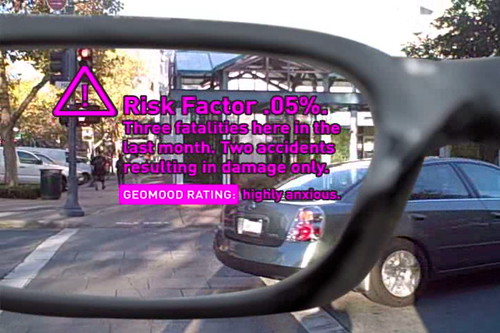
Check out They Live.
Why do I blog this? A strong, avuncular urge to think about other possible augmentations of reality and an allergic reaction to the ways engineer-accountant led designed things turn out.
But wait..there’s always more…this video, found by pheezy on the Twitter and created by Anatoly Zenkov (wow..), is another useful instance of a proper AR experience. I mean..one that makes a lot more sense in that it exhibits the kinds of reality I’ve come to know and love and appreciate and understand from first principles.
Me too (doing some AR stuff)! from Anatoly Zenkov on Vimeo.
…and even more, more..this thing has come in from the Bureau’s phalanx of data scouring agents..an AR-y miniature house maid, done in the fine, Japanese style of Lolita Maid-o!
Subtly Noted
After passing by this a couple of times walking back from Venice Beach, I can’t help but wonder if this Pepsi advertisement is an allusion to the Obama victory. Without clearly saying so, it may be. I suppose knowing when it went up might help, if I were that interested. in any case, I can’t think of what else in the cultural landscape over the recent months might lead to one thinking — Hooray! Bernie Madoff? $350 billion given away to jackhole bankers? The recently completed building adjacent to the sign that looks like it was done by a barely passing master of architecture grad student?
Workshop on Pervasive Advertising
It amazes me how non-relevant this topic is, particularly nowadays when there can be little reason to entice a consumer to engage in letting loose of whatever cash they may have. By the time we get out of the current morass of mistrust, misspending and misguided expectations of a world where all the growth graphs go up and to the right, we should be happy to have a pair of trousers that fit and a spigot with potable water running out of it.
But, the topic of pervasive advertising goes further than that. What could the outcome of a workshop be other than..a world of pervasive advertising. I mean, working out the details is all good, but what about a workshop on a world without advertising? Could that even be possible to have without essentially saying you’re going to quit your job as an engineer/scientist of pervasive stuff?
It just turns out that the vision of a near future of pervasively advertised-to humans just comes out all wrong. It’s only ever annoying and bothersome, or a horrid expression of human-database symbiosis.
There’s really not much more of an end game for pervasive advertising than that of the extrapolation of today’s conditions as in the remarkable design fiction of Spielberg’s visual rendering of P.K. Dick’s “Minority Report”. The assemblage of participants in the world of advertising is optimized for itself, which is well-greased linkages between me, my “interests” (to the extent these translate into commerce) and those who have something to gain in economic terms from selling me my interests. It’s optimized to leverage the pervasively networked, databased world and this can only lead to an intensely uninspired, technically awesome, intrusive and annoying world. It can’t really go any other way than that shown in the various compelling and fascistic interpretations in “Minority Report” of the pervasive advertising future – retinal scanning, holographic “pop-up” adverts, yammering cereal boxes with laminated displays and gesture recognition (to know when I’m trying to tell it to stop yammering, which is guaranteed to fail any number of times, as adroitly shown in Spielberg’s film), fascistic large urban screens, etc.
Yet, this workshop sounds pleasantly inviting. I don’t, though, see how the conditions of possibility for a world of pervasive advertising would lead to anything but the nuisance we experience today, times a billion. Who knows. Maybe today’s economic blight will wipe advertising as we know it off the face of the map for something else. What that is, i have no idea but so long as we think of advertising as a “sure thing” along with death and taxes, it’ll be nothing more than what it is today, except with a few network links and even bigger screens. We’ll still have “pop-ups” only they’ll stand in front of us when we try to get from here to there. We’ll still have messages on otherwise blank walls reminding us to give feedback on that Torx wrench we just bought from Callium Carbide Tools of Peoria last week. I mean..sounds wretched.
$100 for the first person who can come up with a compelling imaginary of a world without advertising, and one that renders viable and with a buzzing economy.
CALL FOR PAPERS
1st Workshop on Pervasive Advertising
In conjunction with Pervasive 2009
May 11, 2009 – Nara, Japanhttp://pervasiveadvertising.org
Submission Deadline: February 10, 2009
“The only sure things in life are death, taxes and advertising. Although
pervasive technologies cannot avoid death or lessen the pain from
taxation, advertising is fertile ground for research on pervasive
technologies.”[[What ninny said this?? What? Did Moses take out a 2 minute spot during the parting of the Red Sea? If this is the principle of pervasive advertising, fatwa on all pervasive advertising workshops! If advertising really is a necessary evil, like death and taxes, lets get to work on making it an obsolete evil thing that has been eradicated, like the Pox and Foot and Mouth disease; get rid of it already. Or get onto something different and inspired and more in keeping with the times. Stop twiddling about with technologized versions of the same old crap. Seriously.]]
======================================================================
Electronic displays have become ubiquitous and replace traditional
posters and billboards. Hence they not only provide a way of showing
dynamically updated content, but also means to react implicitly and
explicitly to the audience in their vicinity. In order to interact with
the target audience, technologies need to be explored capable of
identifying the user or his interests / needs.[[Well, this is speculative. I see plenty of peeling wheat-paste-ups all over the place. but, okay. Let’s assume that J.C. Decaux is well-positioned to introduce digital displays ubiquitously. Do I want to know that they’re linked to a database of me? Who is J.C. Decaux anyway? Can I tell him to leave my database alone?]]
The current generation of mobile phones come with high speed Internet
access and built-in location sensing. Those properties make mobile
phones a powerful mediator between the advertiser / advertising platform
and the customer.[[Good God. That’s just wrong. I mean, who wants an ad to pop up on their phone?? I have enough trouble when I get an SMS. Seriously. Who is it? Am I missing something here?]]
Social networks such as Facebook, MySpace or LinkedIn are rapidly
growing. Such platforms include detailed information not only on the
interests of users (based for example on profiles and histories) but
also on their network. This information is placed on the Internet and
shared with friends or even the public.[[Yeah, but under my own terms. Or should be. Can I opt out of pervasive advertising networks?]]
These technological advances, and others, change the opportunities and
challenges for advertising radically.[[Not really. It’s the same crap, only with a network and a database and real-time data links. Really. Don’t fool yourself to think that something innovative is going on here. It’s just optimization of an existing schema for knots and linkages between my wallet, my sensibilities and some company some where.]]
Consequently, advertising is becoming one of the major drivers of
pervasive computing technology for many end-users (e.g. mobile ads,
digital signs, context awareness, RFID). Yet we believe that the
attention this topic received in the pervasive computing community does
not equal its immediate impact on society.Taking a positive view we can envision advertisements that precisely
match a person’s interests and fit the current situation so well that
people enjoy receiving them and see advertising as a pleasant
distraction. On the contrary taking a negative view one could imagine a
world where people cannot escape from advertisement, where we are
continuously tracked and where advertisements reduce the quality of
life. Both views even though very extreme are worthy of further
discussion. Hence we hope to provide a venue for this discussion by
offering this workshop.[[I’ll be looking for the workshop write-up. I’m dubious. No one in my mind has come up with anything other than that which will lead to the “Minority Report” imaginary. Seriously. As pleasant as it is shown in the PowerPoint, it’s always enormous screens beaming down to me Coca-Cola ads or encouraging me to buy a watch only someone like Sir Edmund Hillary would wear..you know, those big, multi-face “chronometers” that look like an exercise weight.]]
PAPER SUBMISSION AND PARTICIPATION
We ask potential attendees to submit 2-4 page papers describing their
research interest and particular focus on the workshop topic. The paper
may include the description of ongoing research, results found,
experience gathered, new ideas, future projects or questions on topics
related to pervasive computing and advertising. Each participant is
asked to provide a short paragraph (up to 200 words) on their vision of
advertising in 25 years from now. All submissions will be peer-reviewed.More information can be found at
http://pervasiveadvertising.orgAll submissions must be sent electronically to joerg.mueller@uni-muenster.de
The format for submissions is Springer LNCS, the same as that of
Pervasive 09.
Templates can be found at
http://www.springer.com/computer/lncs?SGWID=0-164-7-72376-0Papers should be no longer than 4 pages. All papers must be submitted in
PDF. At least one author for each accepted paper is expected to attend
the workshop.Non-archival working notes will be produced containing the papers
presented at the workshop. Selected papers from the workshop may be
considered for expansion and inclusion in a special issue of a journal.IMPORTANT DATES
* February 10, 2009: Deadline for electronic submission
* March 1, 2009: Author Notification
* May 1, 2009: Submission of camera-ready
* May 11, 2009: Pervasive Advertising Workshop at Pervasive 2009WORKSHOP ORGANIZERS
Jörg Müller, University of Münster
E-mail: joerg.mueller@uni-muenster.deAlbrecht Schmidt, University of Duisburg-Essen
E-mail: albrecht.schmidt@acm.orgBo Begole, PARC
E-mail: bo@parc.comAaron Quigley, University College Dublin
E-mail: aquigley@ucd.ie
Why do I blog this? I dunno. This stuff kinda bugs me, if you can’t tell. It’s pretty clear that the angle is to create something that has commercial viability, rather than thinking things through for an alternative near future of connecting people, interests, ideas and so forth. On the one hand, it’s exciting and futuristic stuff. On the other hand, it’s not a future that I think has particularly exciting prospects in the category of “habitable”, fun, non-invasive, non-bothersome, non-pop-up-in-your-face futures. And, the advertising thing. I’m serious. If someone can’t paint a picture of a world without advertising..I’m listening. And I got your $100 here.
Continue reading Workshop on Pervasive Advertising
1×1 White Pixel Space
Services Offered
Advertising services for a handyman, improvising placement and using available/upcycled materials — in this case, a paper sleeve for a compact disc.
This is a peculiar instance of advertisement by an individual (“mike”) to find a bit of work for himself, presumably. For risking an invasion of privacy by sharing his phone number (personal? home? business? mobile?), he is able to announce his service and a means of contact — all without incurring a substantial financial risk that might occur with a more traditional, less improvised means of advertising.
I’ve done a stretch in advertising. First at Messner Vetere Berger McNamee Schmetterer Euro RSCG when they were kicking off an “interactive” agency (great learning experience — I had no idea how the trade worked, practically and at a “top-level”. Then — well, at Organic, Liquid Digital, Sterling Brands. Nutty days.
During all of that, I was never particularly excited by what were considered “innovations” in advertising and brand marketing. One always got a whiff of sulfar when a slick agency partner announced some revolution or another. Whether it was ad banners that appear on..web pages! Or SMS messages that tickle your phone when you walk by a Starbucks with a discount on something you hadn’t even considered buying. It was all “communication” designed to compel one to spend money — more often than not, it was to spend money on things that one could reasonably live without. The cycle of consumption has very little principles beyond perpetuating and accelerating spending — even to the point of spending money in a way that drives one towards serious financial distress.
What are the various practices for circulating one’s ability to perform paid services? How can these be organized across schemas of cost, location, metrics of performance? Are there alternatives to traditional means of announcing oneself and one’s willingness and ability to perform services, or other kinds of transactions? What distinguishes “mike’s” strata of communication from others — both more formal (“professional advertising”) and informal? If advertising is a form of communication
Why do I blog this? I am wondering — is it possible to imagine a world in which the dominant form of advertising operates according to principles other than the perpetuation of cycles of spending? I come up short when I try to imagine such a world. Is it because advertising is the world? Is it so imbricated into the essence of what “our” lives are that its existence defines what life is? Questions ahead.
